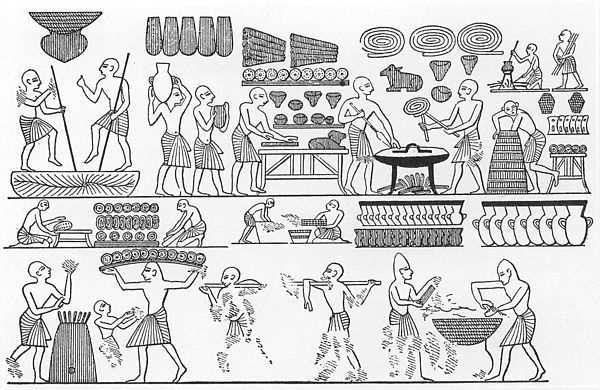Food is an integral part of peoples' culture and heritage, and all holidays, occasions, and celebrations around the world are associated with certain foods that distinguish them from everyday foods.
When Egyptian food is mentioned, the dishes of broad bean, falafel, koshary, and other famous dishes spread in homes and shops alike come to mind. Nevertheless, many do not know that there are tens and perhaps hundreds of food items with a long history that extends back thousands of years.
Many of the delicious dishes we love today have come down to us from ancient Egypt. Although we do not have any menus left from ancient Egypt and there are no direct examples of the foods that the ancient Egyptians cooked and ate, we knew about the essential types they used to eat thanks to objects found in tombs.

The ancient Egyptian civilization was one of the first in the world to understand baking. The Egyptians were the first to invent the fermentation of dough to double its size and the first to make specialized dough. They made bread and pies in all shapes. Moreover, they made different doughs for bread, some of which are still cooked, as they made pies similar to pizza as well as a leafy dough like the famous Egyptian “Feteer Meshaltet.” They used to eat three times a day, and one of these meals had to be a family meal and include the whole family.
According to Rawi magazine, bread was an essential food commodity in many ritual and funeral traditions. Hundreds of loaves of bread remain from ancient Egypt, where they were placed in graves for the deceased to eat. Their shapes varied between cylindrical, rectangular, triangular, as well as animal and human figures.
The tomb of King Ramses III contained many forms of bread and pastries that continued long afterward and through the Ptolemaic era when the Romans introduced them to Europe.
Legumes were the usual folk food. The most important was the foul (harati), which was cooked in different ways and made into soup or bisara. It was offered to ancient Egyptian deities and taken by the priests as an anti-antacid. Lentils and cowpeas were the daily foods for the builders of the pyramids.
The vegetables that the Egyptian farmer ate almost daily were lettuce, watercress, radish, cabbage, cauliflower, green onions, dill, parsley, and coriander, which are all healthy vegetables. The workers and the builders ate garlic every day.
It has always been customary to find lentils at archaeological sites. For example, in one of Thebes' tombs, several tightly packed balls of what looked like cooked brown lentils were found.

In addition, Egyptians put meat (beef, goat, lamb, pork, geese, and pigeons) and fish on the dining table, and scenes often include images representing butchers and birds.
Ancient Egyptians made many sweets from flowers. Lotus flowers are often seen in tombs on offering tables, as they may have been an adornment and beautification for food, or perhaps they were also the same as food. Indeed, Herodotus speaks of the lotus as a food, but scholars are unsure whether he means the lotus flower or it is just a misnomer for something else, according to Rawi magazine.
Honey was used by all classes in ancient Egypt, indicating that it must have been produced on a large scale. It was used for everything from sweetening food to preventing infection by being placed on wounds, and also for paying taxes. Egypt was the oldest country known for beekeeping.
Cow's milk was undoubtedly used, according to ancient scenes of milking. Likely, milk from other animals was also used. Cheese, cream, and products similar to ghee or butter were often produced. It is believed that many of the finds are cheese from ancient Egypt.
One of the favorite ingredients in ancient Egyptian food is Hab al-Aziz, a species in the same family as the papyrus plant. Its delicious tubers are eaten fresh, dried, or roasted and it has been found in tombs dating back to the pre-dynastic period of Egyptian history.
Dishes common even among the poor were bread and beer along with onions, garlic, lentils, leeks, radishes, lettuce, and cucumbers. The fruits enjoyed by the lower classes were figs and sycamores. The Egyptians planted date palms called Amhat, which are still used today as a source for dates.

The kitchen was usually located at the end of the house and was covered with straw and twigs. Its location allowed people to escape the smoke, and it was probably situated in the courtyard of the house, adjacent to or below the dining room. The Egyptian kitchen is simple and includes a clay or stone oven with the necessary cooking utensils. The Egyptians ate their food with their hands while sitting around a tray on a small table. They washed their hands before and after eating.
Food utensils were the mortar, grinder, and dough trough. The oven was made of pottery, and perhaps it was primitive and consisted of a few stones and cooking utensils were placed on it. Small tools included baskets, sieves, pots, spoons, and knives.
The ancient Egyptian made a food offering to his god, such as bread, cakes, and wine, which was served in pots and included meat such as a bull's leg, deer and others. The offering table was also provided to the deceased in his cemetery, and he was then exempted from drawing food on the cemetery wall.












